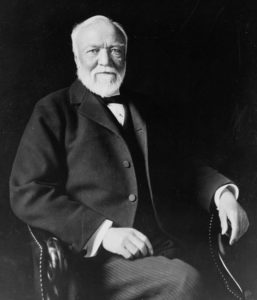 Country of origin: Scotland
Country of origin: Scotland
Year came to U.S.: 1848
Businesses: Carnegie Mellon University (1900), United States Steel (1901), Carnegie Foundation (1905), Carnegie Corporation of New York (1911) and TIAA (1918)
Headquarters: Pittsburgh, PA (United States Steel)
2022 revenue: $9.3 billion (TIAA) and $21.1 billion (United States Steel)
Employees: 3,692 (TIAA) and 22,740 (United States Steel)
Ranked 412 (TIAA) and 186 (United States Steel) in the 2023 Fortune 500
Andrew Carnegie’s steel company produced more metal than all of Great Britain in 1900.
The richest man of his time, his goal was to give away his entire fortune. There are now 2,510 libraries and 22 charitable organizations around the world that bear his name.
Andrew Carnegie is an American icon. He started life as a poor boy in Scotland and became one of the richest and most philanthropic men of all time.
To escape poverty in Scotland, Carnegie immigrated with his family to Pittsburgh at age 13. He started out as a bobbin boy in a cotton factory and moved through a number of jobs until becoming the superintendent of the Western Division of the Pennsylvania Railroad.
While employed by the Railroad, Carnegie invested in a company that manufactured railway sleeping cars. From that success he invested in more companies. By 1863, half of his income came from investments. In 1865, he retired from the railroad and founded his own company, Keystone Bridge Company. His first steel works began in 1873. The steel company prospered, and by 1900 it produced more metal than all of Great Britain.
In 1901, J.P. Morgan bought Carnegie Steel to form United States Steel and paid Carnegie $480 million, making him the world’s richest man. Carnegie then became a full-time philanthropist.
Carnegie was an avid reader. After he arrived in the United States, his only education came from the generosity of a benefactor who made his library available to local working boys. Carnegie returned the favor by donating library buildings. Over time, he endowed 2,510 libraries in communities across the English-speaking world.
To help children of working-class families learn useful trades, Carnegie created a new technical school in the city of Pittsburgh in 1900. It would later merge with the Mellon Institute of Industrial Research, founded by the sons of fellow immigrant entrepreneur Thomas Alexander Mellon, to form Carnegie Mellon University, a globally-recognized university with more than 14,000 students, 109,900 alumni and 4,000 faculty and staff.
Carnegie recognized that adequate pensions were needed to attract talented teachers. In 1918, the Carnegie Foundation established a fully-funded system of pensions for professors called Teachers Insurance and Annuity Association (TIAA). The organization today serves 5 million active and retired employees and has $861 billion in combined assets under management.
These are just some examples of Carnegie’s generosity. In his 1889 book, Gospel of Wealth, he says, “The man who dies thus rich dies disgraced.” By the time of his death in 1919, he had given away nearly $351 million. His $135 million donation to establish the Carnegie Corporation of New York made it the single largest philanthropic trust ever established up to that time. Over a century later, his name is still attached to 22 organizations around the world that do work in fields like scientific research, peace, international affairs, art, and, of course, education.
Updated April 2024
